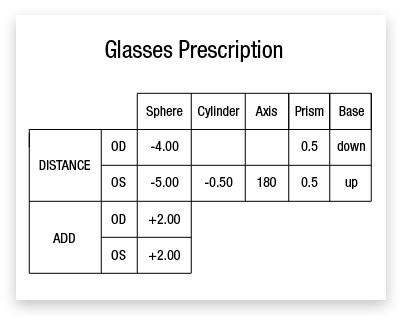So you finally got your eyes checked and came to know that despite all your protests, you DO need glasses. It’s great that you did get your checkup done though, and now that you’ve joined the club, you’ll enjoy the clear vision! But when you got word about the glasses, did you ever wonder about all those numbers and letters on the prescription sheet? It seemed like gibberish to you then, but if you’re curious about what it all means, you’ve come to the right place! We tell you how to read your eyeglasses prescription sheet, and what each term stands for.
OD, OS and OU
First, you would have noticed OD and OS on your sheet. You might have also seen OU, but it’s not necessary each prescription has it. All these terms are Latin abbreviations, and stand for ‘Oculus Dexter’, ‘Oculus Sinister’ and ‘Oculus Uterque’ respectively. They may sound complex, but they stand for something very simple, they’re just fancy words for your eyes. Yep, oculus dexter means right eye, and oculus sinister means left eye. Oculus uterque, means both eyes. So the values next to each OD and OS column mean that they apply to that particular eye. If there’s an OU thrown in, it means both eyes have to be adjusted by that common value. Talk about complicating things, right?
DV and NV
Next, you would have noticed something called ‘DV’ and ‘NV’, which stand for distance vision and near vision. Now that you know what they stand for, it’s probably clear what they signify. The first one denotes the correction required for you to see distant objects clearly, and the second one denotes the correction required for nearby objects. This could also signify the reading portion of bifocals, if they’re prescribed. For some patients, ‘Add’ could also mean the additional refractive power required in conjunction with the spherical power.
Spherical (SPH)
Spherical indicates the lens power. It’s pretty much the basic number by which we judge how much vision correction is required, and is measured in diopters (D). The numbers that you see in this part are either in positive or negative (+ or -). The plus sign denotes farsightedness, and the minus sign denotes shortsightedness. The term itself means that the whole eye has to be corrected, and that the correction is spherical, or equal in all meridians of the eye.
Cylindrical (CYL)
Cylindrical lenses are required for astigmatic people, and are also measured in diopters. Astigmatism is a condition in which the optics of the eye cannot focus a point object sharply enough into a focused image on the retina. This usually happens due to an irregular curvature of the lens or cornea. It’s corrected by using cylindrical lens. If your prescription has nothing in this section, it means that you don’t have astigmatism, if you see a number, it means that a particular median has to be corrected. Similar to the spherical section, + denotes farsighted astigmatism, and – denotes shortsighted astigmatism.
Axis
Now, if you require a cylindrical lens, the lensmaker will need to understand at what meridian angle the correction is required, as we mentioned earlier. You will find a number from 1 to 180 here, which is angle at which correction is required. 90 denotes the vertical meridian, and 180 denotes the horizontal meridian of the eye. Without this value, the cylindrical value mentioned above would make no sense at all.
Prism
Very few prescriptions have something written under the prism section. This is the amount of prismatic power, measured in prism diopters, required to compensate for eye alignment problems. Any sort of imbalances or muscle issues can be corrected by the value prescribed in this section.
Base
Finally, we have base, which is connected to the value prescribed in the prism section. Base refers to the direction of displacement of the prismatic correction. Here, if there’s a prism value, you will find one of four abbreviations. They are:
- BU (Base Up): Refers to displacement upwards.
- BD (Base Down): Refers to displacement downwards.
- BI (Base In): Refers to displacement towards the user’s nose.
- BO (Base Out): Refers to displacement outwards from the user’s nose.
We hope that you can now understand what all these terms mean, and can read the prescription sheet. Do let us know if you have any questions!
Checkout this to Buy Power Sunglasses.
Image Credits: improve-vision-naturally.com
